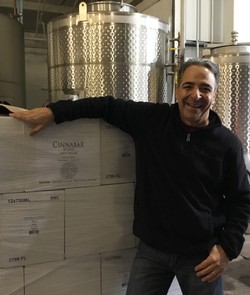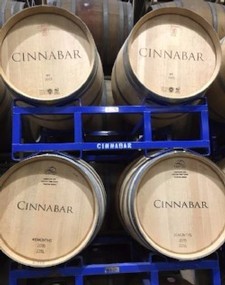In the Cellar with George
 Welcome to In the Cellar with George, a blog in which Cinnabar Winemaker George Troquato shares his insights on wine, wine making, viticulture, and more.
Welcome to In the Cellar with George, a blog in which Cinnabar Winemaker George Troquato shares his insights on wine, wine making, viticulture, and more.
One could say that farming is in George's blood. He began helping his father at Troquato Vineyards in 1985 after graduating Cal Poly with a degree in crop science, before gaining experience working in the cellar and later in the Beaujolais region of France. He has a profound understanding of winemaking—from the vineyard to the glass.
Read more about George's winemaking philosophy.
Life in a Barrel

This is a special time of year when wine is developing in-barrel, where harmony is in the making. So, what goes on inside those hallowed, oak halls? As soon as the wine goes in-barrel it undergoes malolactic fermentation (ML)—the process by which the acids in the grape go from malic to lactic. But the acids aren’t the only components. The wood itself plays a critical role. Cinnabar uses American and French oak barrels.
Barrels are made by “coopers.” First, the wooden staves used to create the barrel are weathered outside for two to three years to season the wood and soften the tannins. After the barrel is formed, it is toasted over heat and the sugars in the wood caramelize, adding a level of complexity. Oak barrels differ in character: American oak is sweeter and imparts aromas and flavors of vanilla, coconut, and dill. Whereas, French oak has some vanilla but is less sweet and gives wine more spice and tannin character. Oak barrels also help wine develop by allowing a micro amount of oxygen to interact with the wine, helping the wine evolve from primary fruit (grapy) to complex aromas, flavors, richness, and texture in addition to stabilizing the color and clarifying the wine.
Cheers,
George Troquato, Winemaker
Puttin' On the Heat: Fermentation Time in the Cellar

We may be done harvesting grapes, but there is still a lot of work to do. As I write this, some fermentations are still active. Our Santa Cruz Mountains Chardonnay, which is entirely barrel-fermented using native yeast, can take up to five months to complete primary and secondary fermentation—the conversion of malic acid (tart) in the grapes to lactic acid (soft, buttery quality).
Our other wines are fermented in stainless steel tanks. We make sure that the wines are fully fermented (all of the sugars have been converted to alcohol). At that point, the skins are pressed and the wine is transferred to settling tanks to settle out the solids before putting the wine in barrels. Primary fermentation takes two weeks. Then a new process begins: secondary fermentation, which is a bacterial activity that generally occurs in-barrel. All red wines go through malolactic fermentation (ML) to ensure stability. ML can take a long time so we monitor it until completion, around the start of the new year.
Cheers,
George Troquato, Winemaker